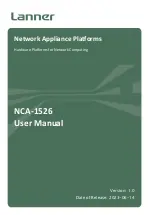
STS−n is an interleaving of multiple (n) STS−1s. The size of the payload and the overhead are multiplied by
n. Figure 3.4 displays an STS diagram.
Figure 3.4: The STS−1 framing and STS−n framing. The overhead and payload are proportionate to the n
value, with the STS−1 frame as the base.
You may wonder why we’re talking about synchronous transmission when we said it is only used over short
distances. Where did the asynchronous transmission go? Well, the asynchronous traffic is encapsulated in the
STS payload. The asynchronous serial transmission eliminates the need for the synchronization of the end
transmitting equipment. In SONET, most WAN links are a point−to−point connection utilizing light as the
signaling source. The time required for the signal to travel the link does not distort the synchronization. The
OC−n signal itself is used for the synchronization between equipment. This combination of asynchronous and
synchronous serial transmission enables signals to reach across long distances with minimal overhead.
Cisco WAN Switches
The current Cisco WAN product line consists of the following switches:
MGX 8200 series
•
IGX 8400 series
•
BPX 8600 series wide−area switches
•
MGX 8800 series wide−area edge switches
•
MGX 8200 Series
The Cisco MGX 8200 series is designed to function as a WAN edge device. It combines multiple narrowband
transmissions into a single broadband trunk. It functions as a standalone unit to connect to the ATM network
or it can be used as a feeder device to other WAN switches. The series consists of the MGX 8220 Edge
Concentrator, the MGX 8240 Private Line Service Gateway, and the MGX 8260 Media Gateway.
The MGX 8220 Edge Concentrator has 16 slots with the capability for full redundancy. It accepts two classes
of modules: common control cards and function modules. Six slots are reserved for common control cards,
and 10 slots are reserved for function modules. The common control card consists of an AXIS Shelf
Controller (ASC) card, a Service Resource Module (SRM) card, and a service trunk card. Each card can use
either of two specific slots. When both slots are occupied, one of them acts as a hot standby. The ASC card
provides a user interface for the overall control, configuration, and management of the unit. The SRM controls
the flow of traffic from the trunk card to various function modules. The service trunk module is the only
broadband interface (OC−3 or T3) that transports the aggregated traffic to the ATM network. The function
modules are narrowband interface cards. The narrowband transmission can be T1, high−speed Frame Relay,
57
Summary of Contents for Catalyst 1900 Series
Page 1: ......
















































